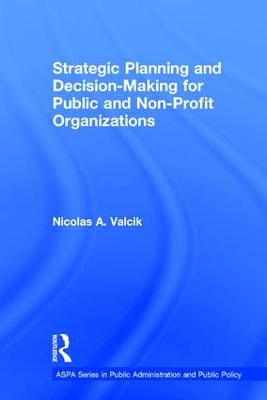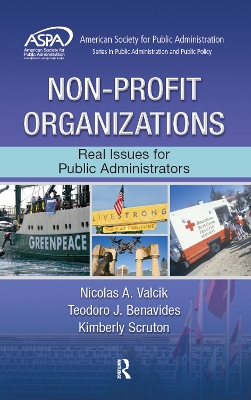ASPA Series in Public Administration and Public Policy
5 total works
Practical Human Resources for Public Managers
by Nicolas A. Valcik and Teodoro J Benavides
Employers face a myriad of issues when hiring: how to recruit, whom to select, how to interview, Equal Employment Opportunity policies, fair salary offerings, health issues, performance evaluations, behavior/disciplinary actions, turnover, and the list goes on and on. Practical Human Resources Management for Public Managers: A Case Study Approach provides insight into human resource trends and demonstrates how complex situations can be successfully managed by public sector practitioners. The authors take us step by step into the "real world" with examples of historical events that compare "What Happened" with "What Could Have Happened" as well as suggested readings for more in-depth analysis and important points to remember.
Exploring the space between theory and what actually occurs in the world, this book supplies instructional case studies based upon actual events. The authors introduce key human resources issues with clear, concise language and provide techniques to address these issues in a real-world setting. The case studies cover legal and liability issues, recruiting and hiring, employee performance, reward and discipline issues, retention, termination, workplace violence, mentorship, motivation, and managing through transitions.
The authors bring know-how from a wide array of working environments, including teaching and administrative experience in public universities and management in municipalities of various population sizes from a few thousand to more than a million. They have also worked in a variety of capacities within these organizations, which allow them to see different perspectives on how different departments handle similar situations. They use their from-the-trenches knowledge to explore pragmatic ways to deal with human resource issues in public sector workplaces.
Strategic Planning and Decision-Making for Public and Non-Profit Organizations
by Nicolas A. Valcik
This book provides administrators in public and non-profit organizations with direction and a framework from which to lead their organizations effectively. Taking a global approach to the issues administrators need to examine when managing a group of employees at any level (including budgeting and expenditures, forecasting, policy creation and execution, communication and reporting), this book explores the driving forces in organizational decision making. Author Nick Valcik takes a holistic view on organizational management, beginning with the core aspects of public organizations and the leadership competencies necessary to manage an organization successfully. Designed to be used on undergraduate and graduate courses in public administration and in public affairs programs, the book discusses the basics of organizational structure, delves into risk management issues, and offers a set of tools that can be used by administrators to make informed decisions based on actual data or documented processes. Throughout the book, real world case studies provide students and practitioners with a clear understanding of how exactly the right decision tool may be applied when facing a particular decision in any organization.
Case Studies in Disaster Response and Emergency Management
by Nicolas A. Valcik and Paul E. Tracy
Designed to enable practitioners and students to evaluate a variety of real-life emergencies from every angle, this new edition of Case Studies in Disaster Response and Emergency Management provides clear, thorough, step-by-step descriptions of more than 50 major disasters or emergencies. Arranged chronologically, the case studies involve incidents from around the globe, with topics including natural disasters, industrial accidents, epidemics, and terrorist attacks. A series of questions throughout each case study encourages the reader to think critically about the problem at hand, to select a course of action, and to then see the results of the decisions that were made. This hands-on approach invites practitioners and students to apply learned theoretical emergency management techniques in a safe test environment.
Case Studies in Disaster Response and Emergency Management, 2e provides readers with the most modern and current case studies in disaster response and emergency management and can be used in group project settings, as individual homework assignments in training courses for first responders, law enforcement, and government employees, or to complement existing emergency management textbooks in Public Administration, Public Management, and Public Affairs programs.
City Planning for the Public Manager
by Nicolas A. Valcik, Todd Jordan, and Teodoro J Benavides
Why should public administrators care about city planning? Is city planning not a field ruled by architects and public works personnel? Much of city planning in fact requires expertise in areas other than buildings and infrastructure, and with city planning expertise, urban administrators are empowered to make more informed decisions on matters that involve budgeting, economic development, tax revenues, public relations, and ordinances and policies that will benefit the community. City Planning for the Public Manager is designed to fill a gap in the urban administration literature, offering students and practitioners hands-on, practical advice from experts with diverse city administration experience, and demonstrating where theory and practice intersect.
Divided into three sections, the book provides an overview of the life cycle of a municipality and its services, explores city planning applications for planners on a strict budget, and walks the reader through a real-life planning research project, demonstrating how it was formulated, implemented, and analyzed to produce usable results. Topics explored include justifications for specific city services, internal and external benchmarking used for city planning, common technical tools (e.g., GIS), legal aspects of planning and zoning, environmental concerns, transportation, residential planning, business district planning, and infrastructure. City Planning for the Public Manager is required reading for students of urban administration and practicing city administrators interested in improving their careers and their communities.




